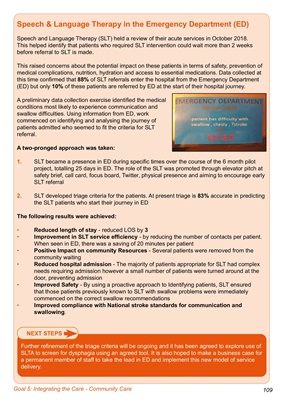
Speech & Language Therapy in the Emergency Department (ED)
Speech and Language Therapy (SLT) held a review of their acute services in October 2018.
This helped identify that patients who required SLT intervention could wait more than 2 weeks
before referral to SLT is made.
This raised concerns about the potential impact on these patients in terms of safety, prevention of
medical complications, nutrition, hydration and access to essential medications. Data collected at
this time confirmed that 88% of SLT referrals enter the hospital from the Emergency Department
(ED) but only 10% of these patients are referred by ED at the start of their hospital journey.
A preliminary data collection exercise identified the medical
conditions most likely to experience communication and
swallow difficulties. Using information from ED, work
commenced on identifying and analysing the journey of
patients admitted who seemed to fit the criteria for SLT
referral.
A two-pronged approach was taken:
1. SLT became a presence in ED during specific times over the course of the 6 month pilot
project, totalling 25 days in ED. The role of the SLT was promoted through elevator pitch at
safety brief, call card, focus board, Twitter, physical presence and aiming to encourage early
SLT referral
2. SLT developed triage criteria for the patients. At present triage is 83% accurate in predicting
the SLT patients who start their journey in ED
The following results were achieved:
• Reduced length of stay - reduced LOS by 3
• Improvement in SLT service efficiency - by reducing the number of contacts per patient.
When seen in ED, there was a saving of 20 minutes per patient
• Positive Impact on community Resources - Several patients were removed from the
community waiting
• Reduced hospital admission - The majority of patients appropriate for SLT had complex
needs requiring admission however a small number of patients were turned around at the
door, preventing admission
• Improved Safety - By using a proactive approach to Identifying patients, SLT ensured
that those patients previously known to SLT with swallow problems were immediately
commenced on the correct swallow recommendations
• Improved compliance with National stroke standards for communication and
swallowing.
Further refinement of the triage criteria will be ongoing and it has been agreed to explore use of
SLTA to screen for dysphagia using an agreed tool. It is also hoped to make a business case for
a permanent member of staff to take the lead in ED and implement this new model of service
delivery.
NEXT STEPS
109
Goal 5: Integrating the Care - Community Care